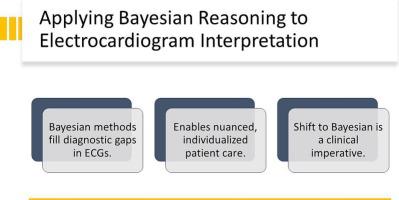Journal of Electrocardiology ( IF 1.3 ) Pub Date : 2023-10-17 , DOI: 10.1016/j.jelectrocard.2023.10.006 José Nunes de Alencar Neto 1

|
Electrocardiograms (ECGs) are a cornerstone in cardiac care. Traditional statistical metrics like sensitivity and specificity are commonly used for diagnostic evaluations but are limited when applied in clinical settings due to their inability to incorporate pre-test likelihoods or individual patient context. Traditional diagnostic metrics do not provide a complete picture in clinical scenarios. Bayesian reasoning allows for a more nuanced approach, integrating pre-test probabilities and individual patient context to produce more accurate post-test probabilities. This was demonstrated through Bayesian analysis of four clinical cases. Bayesian reasoning enhances diagnostic accuracy and personalizes patient care by integrating prior probabilities into diagnostic decision-making. This shift toward Bayesian reasoning is crucial for improving patient outcomes in the era of evidence-based medicine.
中文翻译:

将贝叶斯推理应用于心电图解释
心电图 (ECG) 是心脏护理的基石。敏感性和特异性等传统统计指标通常用于诊断评估,但在临床环境中应用时受到限制,因为它们无法纳入测试前的可能性或个体患者的情况。传统的诊断指标无法提供临床场景的完整情况。贝叶斯推理允许采用更细致的方法,整合测试前概率和个体患者背景,以产生更准确的测试后概率。通过对四个临床病例的贝叶斯分析证明了这一点。贝叶斯推理通过将先验概率整合到诊断决策中来提高诊断准确性并个性化患者护理。在循证医学时代,这种向贝叶斯推理的转变对于改善患者的治疗效果至关重要。



























 京公网安备 11010802027423号
京公网安备 11010802027423号